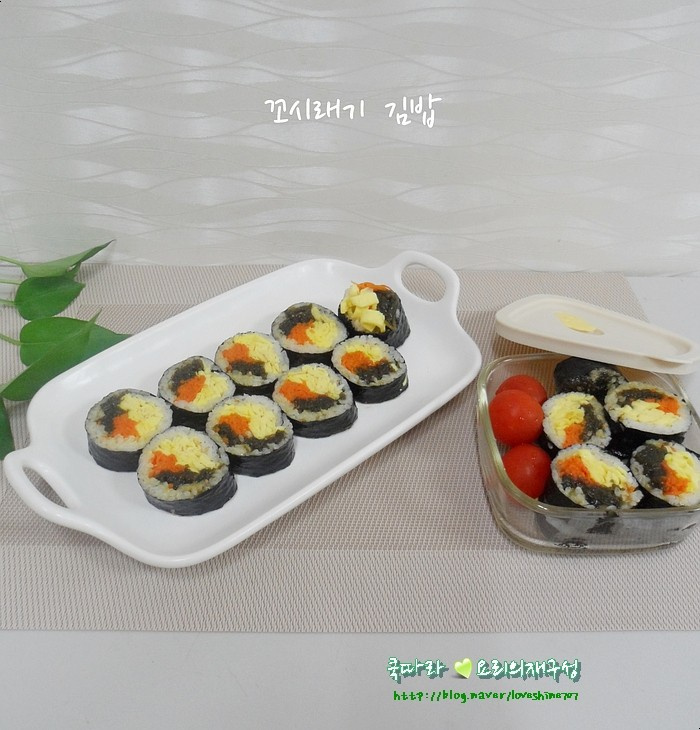Chewy Kosiraegi (Sea Tangle) Kimbap
A Unique Seaweed Kimbap Recipe Using ‘Giwa Jih-o’ Rice from Gyeonggi Province

There’s no meal as satisfying and filling as a rice dish! In this prolonged era of COVID-19, when our bodies and minds can feel exhausted, nothing provides strength like a home-cooked meal made with care. I was recently captivated by the delicious taste of ‘Giwa Jih-o’ rice from Gyeonggi Province, and inspired, I decided to create a unique seaweed kimbap: ‘Kosiraegi Kimbap’. I usually enjoy eating seaweed, and kosiraegi, in particular, has a wonderfully chewy and slightly crunchy texture that makes it a great addition to any dish like seasoned salads, pancakes, rolled omelets, or noodles. My family absolutely loves the taste of kosiraegi! This time, I tried putting it in kimbap, and the result was surprisingly amazing! The sticky, chewy texture of the rice, combined with its subtle sweetness that emerges as you chew, paired perfectly with the kosiraegi kimbap. The rich flavors and diverse textures that unfolded in my mouth earned this kimbap a double thumbs-up from my whole family.
Kimbap Ingredients- 2 servings of cooked rice (warm)
- 2 sheets of kimbap seaweed
- 150g salted kosiraegi (sea tangle)
- 1/2 carrot
- 3 eggs
- A little cooking oil
- A little salt
Rice Seasoning- 1 tsp salt
- 1.5 Tbsp sesame oil
- A little sesame seeds
Kosiraegi Braising Sauce- 50ml water
- 1 Tbsp soy sauce
- 0.5 Tbsp oyster sauce
- 2 Tbsp cooking wine (mirin)
- 1 tsp salt
- 1.5 Tbsp sesame oil
- A little sesame seeds
Kosiraegi Braising Sauce- 50ml water
- 1 Tbsp soy sauce
- 0.5 Tbsp oyster sauce
- 2 Tbsp cooking wine (mirin)
Cooking Instructions
Step 1
Prepare all the ingredients for the kimbap in advance. Fresh ingredients are the foundation of delicious kimbap.

Step 2
Leveraging the characteristics of ‘Giwa Jih-o’ rice, I cooked the rice without soaking it. By using about 10% less water than usual and cooking it in an electric pressure cooker, I achieved perfectly cooked grains that were fluffy, glossy, and delightfully chewy.

Step 3
In the warm rice, add the seasoning ingredients (1 tsp salt, 1.5 Tbsp sesame oil, a little sesame seeds). Gently mix with a spatula, being careful not to mash the rice grains, ensuring the seasoning is evenly distributed. This step allows the flavor to permeate each grain.

Step 4
Rinse the salted kosiraegi several times under cold running water to wash off any excess salt. Then, soak it in clean water for about 30 minutes to remove the saltiness. This process reduces the strong salty taste of kosiraegi and softens it.

Step 5
Crack the 3 eggs into a bowl and whisk well, removing the chalazae (the white stringy parts). Lightly season with a pinch of salt. Heat a pan with a thin layer of cooking oil over low heat, then pour in the egg mixture to create thin, even omelets. Be mindful of the heat to prevent burning.

Step 6
Once the omelets are cooked, let them cool slightly, then slice them into thin strips, about 0.5 cm thick, for the kimbap filling.

Step 7
Peel the carrot and use a peeler to cut it into thin matchsticks. Lightly grease a pan with cooking oil, add the carrot sticks and a pinch of salt, and stir-fry briefly until slightly softened. Avoid overcooking, as they can become mushy.

Step 8
In a small pot or pan, combine all the braising sauce ingredients for the kosiraegi (50ml water, 1 Tbsp soy sauce, 0.5 Tbsp oyster sauce, 2 Tbsp cooking wine). Once the sauce starts to bubble, add the squeezed kosiraegi. Simmer over medium-low heat until the sauce has reduced and coats the kosiraegi nicely. This allows the flavors to penetrate the sea tangle.

Step 9
Here are the prepared ingredients for the kimbap filling. The chewy braised kosiraegi, the julienned egg omelet, and the stir-fried carrots look appetizing.

Step 10
Place a sheet of kimbap seaweed on a bamboo mat. Spread the seasoned rice evenly and thinly over the seaweed, leaving a small margin at the top. Be careful not to spread the rice too thick, or the kimbap might burst when rolled. Arrange the braised kosiraegi, julienned egg, and stir-fried carrots in a line over the rice. Adjust the amount of filling to avoid overstuffing.

Step 11
Using the bamboo mat, roll the kimbap tightly, ensuring the filling stays in place. You can moisten the top edge of the seaweed with a little water or a few grains of rice to help seal the roll. Brush the finished kimbap with a little sesame oil for shine, then slice it into bite-sized pieces and enjoy.

Step 12
Although the ingredients might seem simple at first glance, the braised kosiraegi forms the core flavor of the kimbap, creating a surprisingly delicious result. The chewy texture and savory umami of the kosiraegi blend perfectly with the rice, delivering a rich and satisfying taste.



